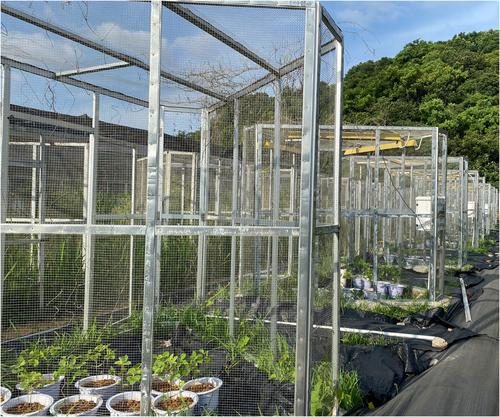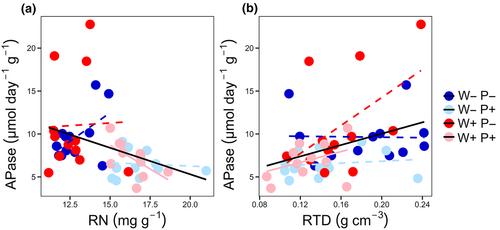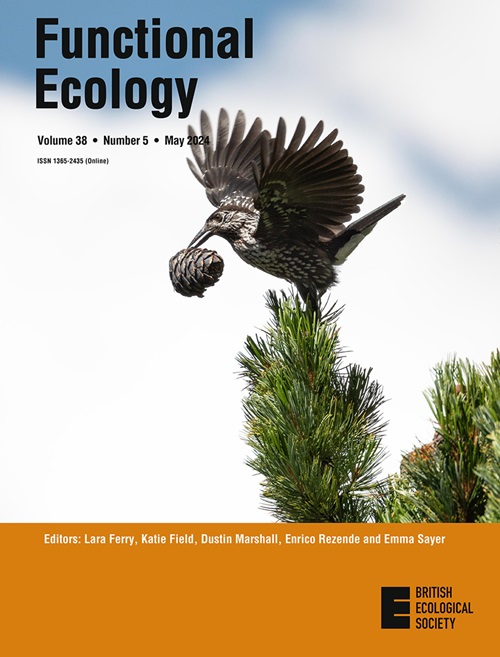气候变暖和寄生虫对根系特征和根系经济学空间的影响
IF 4.6
1区 环境科学与生态学
Q1 ECOLOGY
引用次数: 0
摘要
(2021 年)发现,气候变暖增加了大豆(Glycine max)的 AMF 定殖和 RTD,同时降低了 SRL。这些结果表明,为了应对气候变暖,大豆可能会在根系经济学空间中转向 "外包 "和 "缓慢 "策略。最近,物种分布模型预测,到 2070 年,气候变暖可能会使大豆与其主要害虫之一--菟丝子属寄生植物--之间的潜在生态位重叠增加多达六倍(Cai 等人,2022 年;Shao,1990 年)。寄生植物会强烈抑制寄主植物的生长,并减少寄主植物对地下结构的碳分配(Yuan,Gao,et al.,2023;Yuan & Li,2022;Yuan,Lin,et al.,2023)。例如,我们之前的一项研究表明,菟丝子寄生会减少根系生长和 AMF 在 Bidens pilosa 中的定殖,同时增加氮和磷的浓度(Yuan, Lin, et al.)如果大豆的情况也是如此,寄生虫可能会导致大豆在根系经济学空间中转向 "自己动手 "和 "快速 "策略。为了检验大豆的根系功能特性及其在根系经济空间中的位置是否受到气候变暖和菟丝子寄生的影响,我们在室外进行了一个因子盆栽实验。在寄主植物上,我们测量了根鞘中的SRL、SRA、RD、根氮浓度(RN)、RTD、AMF定殖率(MC)、根瘤生物量(NB)和AP酶活性。我们描述了这些根系性状之间的关系以及大豆植株沿根系经济学空间轴线的位置随气候变暖和寄生现象而发生的变化。我们的假设是:(i) AMF 和根瘤菌的定殖与根系经济学空间中的 "外包 "策略呈正相关;(ii) 气候变暖将通过增加 AMF 和根瘤菌的定殖使大豆植株从 "自己动手 "策略转变为 "外包 "策略,并通过产生具有较高 RTD 和较低 RN 的根系使养分获取策略从 "快 "转变为 "慢";(iii) 寄生虫会减少 AMF 和根瘤菌的定殖,从而使大豆植物从 "外包 "战略转向 "自己动手 "战略,并通过产生较低 RTD 和较高 RN 的根系,使大豆植物从 "慢 "战略转向 "快 "战略;以及 (iv) 当植物同时受到变暖和寄生虫的影响时,它们各自对根系特征的影响将相互中和。本文章由计算机程序翻译,如有差异,请以英文原文为准。


Effects of warming and parasitism on root traits and the root economics space
Read the free Plain Language Summary for this article on the Journal blog.
求助全文
通过发布文献求助,成功后即可免费获取论文全文。
去求助
来源期刊

Functional Ecology
环境科学-生态学
CiteScore
9.00
自引率
1.90%
发文量
243
审稿时长
4 months
期刊介绍:
Functional Ecology publishes high-impact papers that enable a mechanistic understanding of ecological pattern and process from the organismic to the ecosystem scale. Because of the multifaceted nature of this challenge, papers can be based on a wide range of approaches. Thus, manuscripts may vary from physiological, genetics, life-history, and behavioural perspectives for organismal studies to community and biogeochemical studies when the goal is to understand ecosystem and larger scale ecological phenomena. We believe that the diverse nature of our journal is a strength, not a weakness, and we are open-minded about the variety of data, research approaches and types of studies that we publish. Certain key areas will continue to be emphasized: studies that integrate genomics with ecology, studies that examine how key aspects of physiology (e.g., stress) impact the ecology of animals and plants, or vice versa, and how evolution shapes interactions among function and ecological traits. Ecology has increasingly moved towards the realization that organismal traits and activities are vital for understanding community dynamics and ecosystem processes, particularly in response to the rapid global changes occurring in earth’s environment, and Functional Ecology aims to publish such integrative papers.
 求助内容:
求助内容: 应助结果提醒方式:
应助结果提醒方式:


